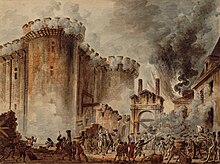| Millennium |
|---|
| 2nd millennium |
| Centuries |
| Timelines |
| State leaders |
| Decades |
| Categories: |
|
Births – Deaths Establishments – Disestablishments |




The 18th century lasted from 1 January 1701 (represented by the Roman numerals MDCCI) to 31 December 1800 (MDCCC). During the 18th century, elements of Enlightenment thinking culminated in the Atlantic Revolutions. Revolutions began to challenge the legitimacy of monarchical and aristocratic power structures. The Industrial Revolution began during mid-century, leading to radical changes in human society and the environment. The European colonization of the Americas and other parts of the world intensified and associated mass migrations of people grew in size as part of the Age of Sail. During the century, slave trading expanded across the shores of the Atlantic Ocean, while declining in Russia[1] and China.[2]
Western historians have occasionally defined the 18th century otherwise for the purposes of their work. For example, the "short" 18th century may be defined as 1715–1789, denoting the period of time between the death of Louis XIV of France and the start of the French Revolution, with an emphasis on directly interconnected events.[3][4] To historians who expand the century to include larger historical movements, the "long" 18th century[5] may run from the Glorious Revolution of 1688 to the Battle of Waterloo in 1815[6] or even later.[7]
In Europe, philosophers ushered in the Age of Enlightenment. This period coincided with the French Revolution of 1789, and was later compromised by the excesses of the Reign of Terror. At first, many monarchies of Europe embraced Enlightenment ideals, but in the wake of the French Revolution they feared loss of power and formed broad coalitions to oppose the French Republic in the French Revolutionary Wars. Various conflicts throughout the century, including the War of the Spanish Succession and the Seven Years' War, saw Great Britain triumph over its rivals to become the preeminent power in Europe. However, Britain's attempts to exert its authority over the Thirteen Colonies became a catalyst for the American Revolution. The 18th century also marked the end of the Polish–Lithuanian Commonwealth as an independent state. Its semi-democratic government system was not robust enough to prevent partition by the neighboring states of Austria, Prussia, and Russia.
In West Asia, Nader Shah led Persia in successful military campaigns. The Ottoman Empire experienced an unprecedented period of peace and economic expansion, taking no part in European wars from 1740 to 1768. As a result, the empire was not exposed to Europe's military improvements during the Seven Years' War. The Ottoman military consequently lagged behind and suffered several defeats against Russia in the second half of the century.
In South Asia, the death of Mughal emperor Aurangzeb was followed by the expansion of the Maratha Confederacy and an increasing level of European influence and control in the region. In 1739, Persian emperor Nader Shah invaded and plundered Delhi, the capital of the Mughal Empire. Later, his general Ahmad Shah Durrani scored another victory against the Marathas, the then dominant power in India, in the Third Battle of Panipat in 1761.[8] By the middle of the century, the British East India Company began to conquer eastern India,[9][8] and by the end of the century, the Anglo-Mysore Wars against Tipu Sultan and his father Hyder Ali, led to Company rule over the south.[10][11]
In East Asia, the century marked the High Qing era and the continual seclusion policy of the Tokugawa shogunate.
In Southeast Asia, the Konbaung–Ayutthaya Wars and the Tây Sơn Wars broke out while the Dutch East India Company established increasing levels of control over the Mataram Sultanate.
In Africa, the Ethiopian Empire underwent the Zemene Mesafint, a period when the country was ruled by a class of regional noblemen and the emperor was merely a figurehead. The Atlantic slave trade also saw the continued involvement of states such as the Oyo Empire.
In Oceania, the European colonization of Australia and New Zealand began during the late half of the century.
In the Americas, the United States declared its independence from Great Britain. In 1776, Thomas Jefferson wrote the Declaration of Independence. In 1789, George Washington was inaugurated as the first president. Benjamin Franklin traveled to Europe where he was hailed as an inventor. Examples of his inventions include the lightning rod and bifocal glasses. Túpac Amaru II led an uprising that sought to end Spanish colonial rule in Peru.
- ^ Volkov, Sergey. Concise History of Imperial Russia.
- ^ Rowe, William T. China's Last Empire.
- ^ Anderson, M. S. (1979). Historians and Eighteenth-Century Europe, 1715–1789. Oxford University Press. ISBN 978-0-19-822548-5. OCLC 185538307.
- ^ Ribeiro, Aileen (2002). Dress in Eighteenth-Century Europe 1715–1789 (revised ed.). Yale University Press. ISBN 978-0-300-09151-9. OCLC 186413657.
- ^ Baines, Paul (2004). The Long 18th Century. London: Arnold. ISBN 978-0-340-81372-0.
- ^ Marshall, P. J., ed. (2001). The Oxford History of the British Empire: Volume II: The Eighteenth Century (Oxford History of the British Empire). Oxford University Press, USA. ISBN 978-0-19-924677-9. OCLC 174866045., "Introduction" by P. J. Marshall, page 1
- ^ O'Gorman, Frank (1997). The Long Eighteenth Century: British Political and Social History 1688–1832 (The Arnold History of Britain Series). A Hodder Arnold Publication. ISBN 978-0-340-56751-7. OCLC 243883533.
- ^ a b Chandra, Bipin. Mordern India. India.
- ^ Campbell, John; Watts, William (1760). Memoirs of the Revolution in Bengal, anno Dom. 1757. A. Millar, London.
- ^ Parthasarathi, Prasannan (2011), Why Europe Grew Rich and Asia Did Not: Global Economic Divergence, 1600–1850, Cambridge University Press, p. 207, ISBN 978-1-139-49889-0
- ^ Allana, Gulam (1988). Muslim political thought through the ages: 1562–1947 (2 ed.). Pennsylvania State University, Pennsylvania: Royal Book Company. p. 78. ISBN 9789694070919. Retrieved 18 January 2013.